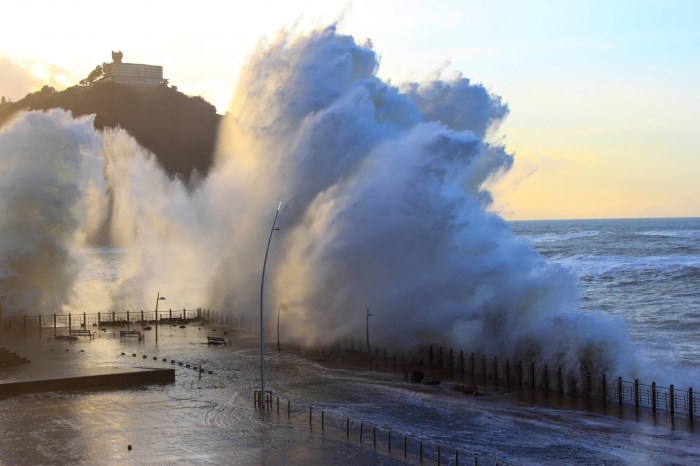The amount of seawater that periodically rises, known as tides, storm surges, and sea level rise, is a complex and fascinating phenomenon that shapes our planet’s coastlines and ecosystems. From the rhythmic ebb and flow of high and low tides to the devastating impacts of storm surges and the long-term consequences of sea level rise due to climate change, understanding these periodic seawater level changes is crucial for coastal communities and the global environment.
This comprehensive overview will explore the causes, mechanisms, and impacts of these seawater level fluctuations, providing insights into their significance and the challenges they pose to coastal regions worldwide.
Definition and Explanation of “Amount of Seawater that Periodically Rises”

The amount of seawater that periodically rises refers to the variations in sea level that occur over time. These fluctuations are influenced by a combination of factors, including tides, storm surges, and long-term sea level rise due to climate change.
Sea level changes can have significant impacts on coastal ecosystems and infrastructure, making it crucial to understand the causes and patterns of these variations.
Tides: A Primary Driver of Periodic Seawater Rise
Tides are the most noticeable form of periodic seawater rise. They result from the gravitational pull of the moon and sun on Earth’s oceans.
As the Earth rotates on its axis, different parts of the ocean experience high tides and low tides. High tides occur when the ocean is at its highest point, while low tides occur when the ocean is at its lowest point.
- The moon’s gravitational pull is the primary driver of tides, with the sun’s gravitational pull having a lesser influence.
- Areas with large tidal ranges, such as the Bay of Fundy in Canada, experience significant differences between high and low tides.
Storm Surges: Exceptional Seawater Rise Events
Storm surges are temporary increases in sea level caused by strong winds and low atmospheric pressure associated with storms, such as hurricanes and cyclones.
- Storm surges can cause severe flooding and damage to coastal areas.
- Historical examples of devastating storm surges include Hurricane Katrina in 2005 and Typhoon Haiyan in 2013.
Sea Level Rise Due to Climate Change
Long-term sea level rise is primarily driven by the melting of glaciers and ice caps due to global warming.
- As temperatures rise, glaciers and ice caps melt, adding water to the oceans and causing sea levels to rise.
- Projected global sea level rise poses significant threats to coastal communities and ecosystems.
- Adaptation and mitigation strategies, such as building seawalls and reducing greenhouse gas emissions, are essential to address the impacts of sea level rise.
Impact of Seawater Rise on Coastal Ecosystems and Infrastructure
Seawater rise can have severe impacts on coastal ecosystems and infrastructure.
- Coastal ecosystems, such as wetlands and coral reefs, are vulnerable to rising sea levels and can be damaged or destroyed.
- Coastal infrastructure, such as roads, buildings, and ports, is also threatened by sea level rise, which can lead to flooding, erosion, and damage.
- Adaptation measures, such as building seawalls and restoring wetlands, are necessary to protect coastal communities from the impacts of sea level rise.
Monitoring and Forecasting Seawater Rise, Amount of seawater that periodically rises
Monitoring and forecasting seawater rise is crucial for disaster preparedness and coastal management.
- Sea level monitoring involves using tide gauges, satellites, and other technologies to track changes in sea level over time.
- Accurate forecasting of sea level rise is essential for developing effective adaptation and mitigation strategies.
- Early warning systems for coastal hazards, such as storm surges and tsunamis, can provide valuable time for evacuation and emergency response.
Helpful Answers: Amount Of Seawater That Periodically Rises
What is the primary driver of periodic seawater level changes?
The gravitational pull of the moon and sun on Earth’s oceans is the primary driver of periodic seawater level changes, resulting in the formation of high tides and low tides.
How do storm surges differ from tides?
Storm surges are exceptional seawater rise events caused by strong winds and low atmospheric pressure associated with hurricanes and other storms, while tides are regular, predictable fluctuations in seawater level driven by gravitational forces.
What are the major contributors to sea level rise due to climate change?
The melting of glaciers and ice caps due to rising global temperatures is a major contributor to sea level rise due to climate change, leading to increased ocean volume and higher seawater levels.


